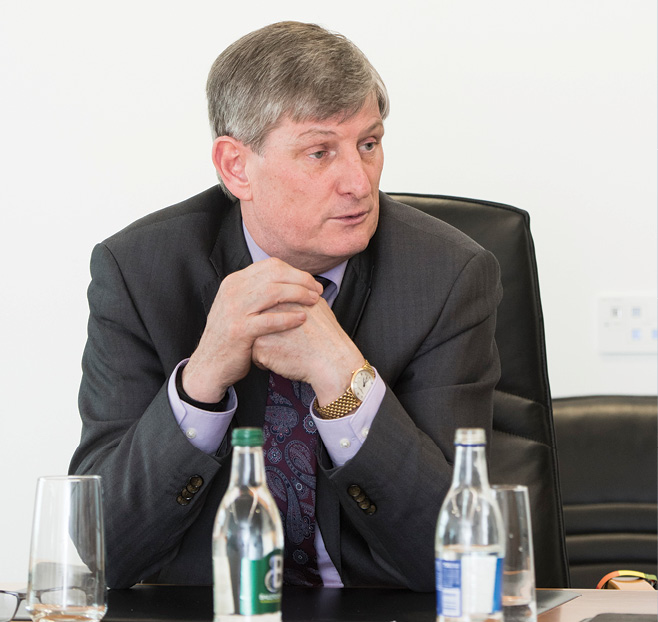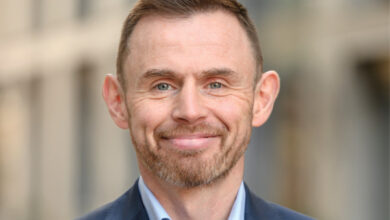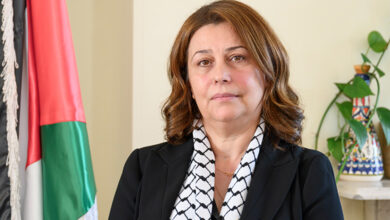Investing in a Brighter Future
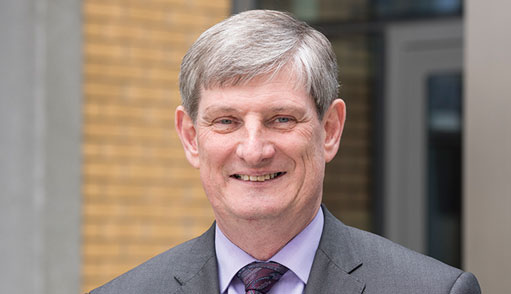
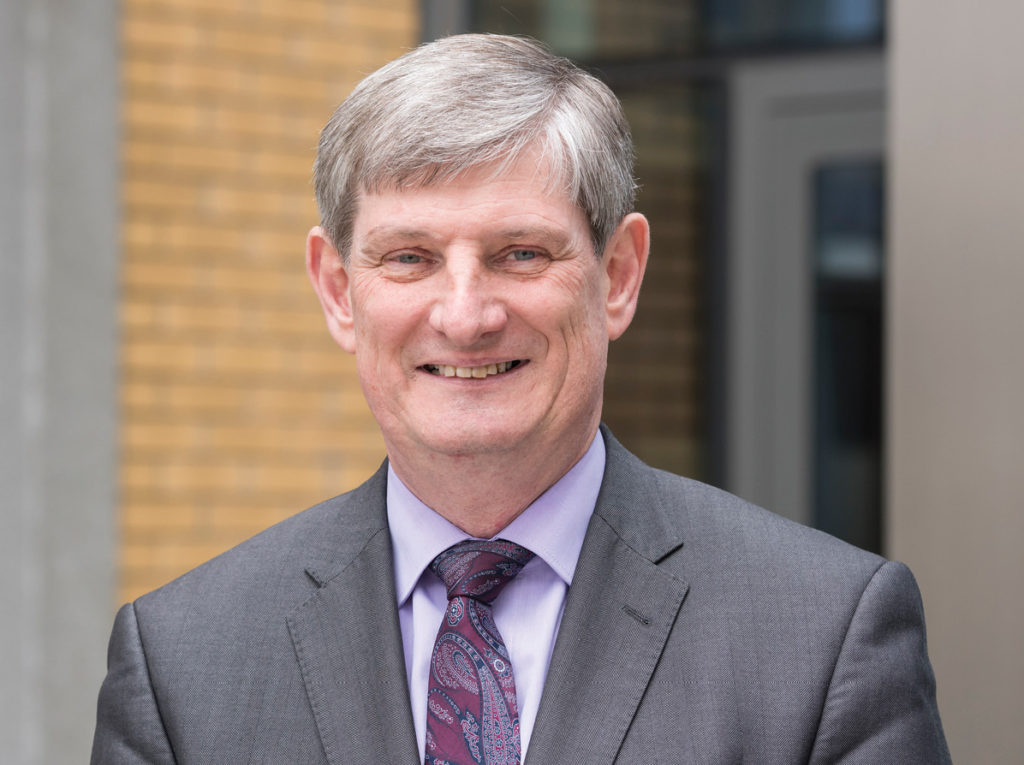
Pat O’Doherty Chief Executive of ESB talks to Owen McQuade about the role of electricity in moving Ireland to a low carbon economy.
Pat O’Doherty is in good form. The Chief Executive of Ireland’s largest energy company is full of his usual enthusiasm despite ESB, like the rest of the energy sector, facing the proverbial perfect storm; climate constraint, technological disruption and geopolitical uncertainty, including Brexit. However, whilst not underestimating the challenges ahead, O’Doherty sees a world of opportunity for the energy utility.
Whilst much of the conversation is about this uncertain future, O’Doherty starts by looking back over the last 90 years since the founding of the semi-state utility. He highlights the critical enabling role electricity has played in bringing about today’s society and economy. In the context of climate change, Ireland will decarbonise its electricity generation by 2050 and that will prove an even greater transition. Electricity accounts for just under 20 per cent of greenhouse gas emissions, with the rest coming from transport, heat and agriculture. Rather than feeling aggrieved that most of policy intervention to date has focused on the 20 per cent, O’Doherty sees an opportunity in the potential to electrify heating and transport which would lead to a 50 per cent reduction in carbon emissions across the economy. “Electricity has played a central enabling role in the economy to date and it will enable a transition to a low carbon future and our strategy is to be a leader in that transition.”
The ESB strategy has four “pillars” for the transition to a low carbon economy. The first is low carbon sources of electricity production, including new technologies. The second pillar is at the other end of the supply chain, where a convergence of enabling technologies, including IT and telecommunications, will put the consumer much more in control of when and how they use electricity. The third pillar brings the production and consumption elements together through the smart network, enabling the connection of different and more dynamic patterns of generation and consumption. “That’s the glue that knits together new forms of generation and consumption and in many cases, these would be at the same location. That’s the ‘pro-consumer’ whereby both industrial and residential customers can be producers and consumers of electricity, and this requires a very different electricity network,” explains O’Doherty.
The fourth pillar is the wider electrification potential: “as we develop the first three pillars, then electricity becomes a further enabler of a low carbon economy through the electrification of heat and transport.”
O’Doherty acknowledges that there has already been much progress made, with Ireland having significantly reduced the carbon intensity of its electricity generation. It has halved over the last 20 years with the shift from oil and combined cycle technologies towards renewable energy. In 2016, nearly 25 per cent of the electricity produced was from wind “which shows the strides made already towards the transition to a low carbon future”.
“Our ambition is to bring that spirit of purpose to lead the transition to a low carbon society based on clean, secure, affordable electricity”
To understand the low carbon future, ESB has undertaken a lot of work with its customers to test their propensity for this new future which O’Doherty articulates as: “beyond kWh, and beyond electricity, towards technology that enables their energy use and their lives.” He highlights some of the innovative development work ESB has been involved in, such as using electric water heating to store energy during times of high wind when prices are low and mentions the utility’s partnership with Durkan Residential in developing the ‘all-electric home’. These futuristic homes combine a high level of insulation with electric heating and have energy bills some 40 per cent lower than average. The project takes customers on a journey and monitors their reactions and perceptions to help develop services that will help the electricity company meet their needs in the future.
In such a fast-changing world, where technologies are developed at increasing rates, how does an energy utility make investment decisions? “In the past, we invested in power stations which were very large investments. In the future, we will make less of those types of investments as the power system will become much more distributed, for example with increasing levels of roof-top and ground-mounted solar panels and battery storage technologies. At present in the single electricity market (SEM) there is surplus capacity and there is unlikely to be any large power station investments for some years. In Britain, ESB has just completed the construction of an 880MW CCGT [combined cycle gas turbine] power plant in Carrington, south Manchester where the GB market needs new capacity. However, he sees most future investment in Ireland being in more distributed technologies and can also see a time when onshore wind will not require financial support. “Subsidies should be used to drive innovation in new technologies that aren’t yet commercially viable,” says O’Doherty.
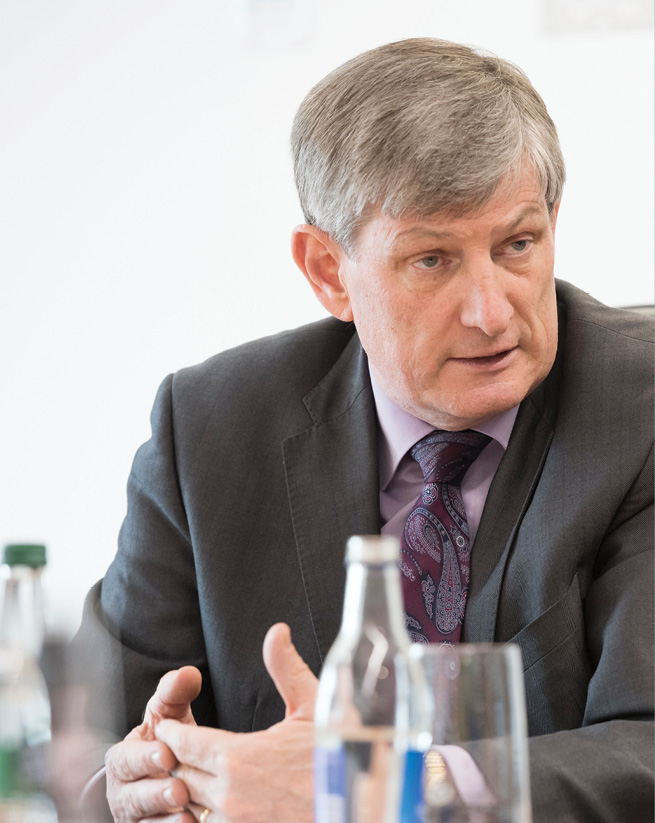
“Ultimately, our business model is about investing in the future.”
Innovation
ESB has always innovated. “We were the first utility in the world, in collaboration with GE, to build a combined cycle gas plant in 1980 in Marina, Co Cork. There has also been huge investment in network automation over the years,” explains O’Doherty. ESB has now made innovation a much more structured part of its business, with the creation of a dedicated innovation division. This division works with partners to deploy new technologies, and with other parts of ESB to drive innovation and improve business performance in all parts of the company’s operations. “It’s a push and pull approach,” he adds. The company has also created an incubator environment for emerging ideas from within the company at Dogpatch Labs, a co-working space for tech start-ups in Dublin’s Docklands. An annual innovation awards for staff encourages new ideas in day to day operations, and acknowledges successes.
When asked: What is top of the ESB board’s list of strategic issues? O’Doherty promptly replies: “Maintaining the financial strength and scale of ESB. That will allow us to invest in the future. Ultimately, our business model is about investing in the future.”
Despite much uncertainty the company is continuing to invest in its networks businesses with up to €600 million invested each year across ESB Networks and NIE Networks and a further €200 million to €300 million invested in generation assets. “That’s over three quarters of a billion euro invested annually in critical energy infrastructure and you need scale and financial strength to do that. We borrow on the international financial markets, so being financially strong is critical to our future.”
In addition to the financial strength of the business, O’Doherty believes that the capability of ESB’s people is equally important: “Success in this business is down to capability, which in turn is all about people.” He highlights ESB’s multi-disciplinary approach which involves engineering, financial, commercial, legal, marketing and customer service teams working together, and in collaboration with external partners, as the key to success.
Over the years ESB has built a very successful international business that is widely recognised across the global utility sector. ESB International has over 500 engineers providing engineering services to utilities in other countries. “This does two things: it allows ESB to internationalise its capability and also allows us to learn what is going on around the world and bring that capability back into the company. ESB International is anchored within the company’s Innovation directorate which recognises the importance of engineering and new energy technologies for our future,” says O’Doherty who once headed up the international division.
The challenge of the market place in these uncertain times is highlighted by O’Doherty as an ongoing issue that impacts on planning for the future. He picks out the European Union’s ‘Winter Package’ as a very ambitious package of measures that will effectively set in place the post-2020 agenda in Europe around decarbonisation. Brexit is another uncertainty he mentions and what it will mean for the energy market: “Ireland is connected to the European energy market through Britain. We will have to work our way through that. The challenge for Britain is that it imports gas and electricity from Europe and we are dependent on imports of gas from them. I’m optimistic that some solution will be found. Britain is not self-sufficient in energy terms and both Europe and Britain will have to find a way of trading gas and electricity in a European market.”
One issue that is holding the attention of ESB is the level of disruption across the entire electricity value chain. Solar and energy storage technologies promise to change things significantly: “I can see a time when solar and storage at a residential level will be viable without a subsidy. That will significantly change the value chain with people generating and storing their own electricity. Whether they choose to sell it back to the grid is a secondary issue,” he continues. “How people will interact with the grid will be very different. If one million homes put 2KW on their roof tops, it is equivalent to the capacity of a 500MW power station.”
Beyond electricity
In developing its services for future markets, ESB now offers smart energy services to large electricity customers, “which helps them use less energy by deploying more efficient technologies and providing services beyond electricity. The model we have adopted allows us to provide funding for investment in new technologies to help customers lower their overall energy consumption, which we then recover through a share of the savings achieved.”
Earlier this year, Electric Ireland launched a new residential solar product, following ESB’s entry to the industrial solar roof-top market two years ago through a 50:50 joint venture with Kingspan. The J-V company offers a funded solar product to businesses, particularly in Northern Ireland where there is a support scheme.
Another joint venture, SIRO, is using the low voltage electricity network to bring 1GB broadband to customers in towns across Ireland in partnership with Vodafone.
O’Doherty believes that through everything it does, ESB will continue to create a brighter future for customers, in Ireland and beyond: “ESB has played a huge part in transforming Ireland for the past 90 years, taking on big ambitious projects to drive social and economic progress and growth. The electricity infrastructure across the whole island, north and south, has been critical to bringing about the modern economy we have today and ESB has been a big part of that journey. That sense of community and commitment to social and economic development is deep in our DNA – it’s our purpose and what sets us apart. Our ambition is to bring that spirit of purpose to lead the transition to a low carbon society based on clean, secure, affordable electricity.”
“In a nutshell, our business plans and investments stack up around that; investing in clean generation; enabling the customer, investing in the smart grid; and moving beyond that to the electrification of heat and transport,” he adds.
In concluding O’Doherty believes that there is huge change ahead in the energy sector: “The overarching thing about this journey is that it is not going to happen overnight. It is going to take decades. It has taken us 90 years to get to this point with the electricity system. Whilst huge strides have been made over the past 20 years, such as Ireland leading the way in terms of wind penetration, there is no magic solution or one size fits all.”
“The real challenge for ESB, and the industry, is to bring customers and policy makers on this journey into unchartered territory, but maybe it is no different to where we were 90 years ago when electricity first came to Ireland. I have a real sense that the same pioneering spirit that was a feature of what we did back then is going to be needed now to take the next leap to further transition to 2050.”
Pat O’Doherty

